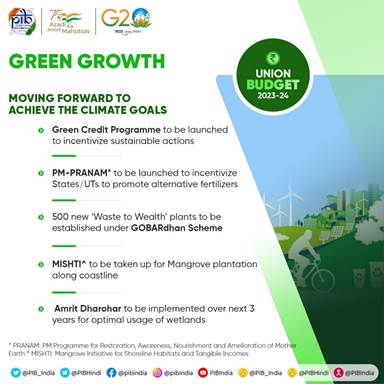Context
-
The Union Budget for 2023-24 announced an initiative for mangrove plantation along the coastline and on salt pan lands, under MISHTI Scheme (Mangrove Initiative for Shoreline Habitats & Tangible Incomes).
How do mangroves help?
- Mangroves are salt-tolerant plant communities found in tropical and subtropical intertidal regions.
- They are important refuges of coastal biodiversity and also act as bio-shields against extreme climatic events.
- With the threat of climate change and frequent tropical storms looming large, planting more mangroves is a welcome development for India which has a coastline of about 7,500 km.

Where do mangroves grow in India?
- The ‘State of World Mangroves 2022’ report by the Global Mangrove Alliance puts the total mangrove cover of the world at 1,47,000 sq km (14.7 million hectares). India has about 4,992 sq km (0.49 million hectares) of mangroves, according to the Indian State of Forest Report (IFSR) 2021.
- Mangroves in India are distributed across nine States and three Union Territories with West Bengal having the highest mangrove cover of 2,114 sq km.
- The IFSR report also points out that there has been an increase in the mangrove cover from 4,046 sq km in 1987 to 4,992 sq km in 2021.
- However, like most other countries, in India too the mangrove ecosystem faces constant pressure due to increasing population in coastal areas and the rising demand for land, timber, fodder, fuel-wood and other non-wood forest products like fisheries.
- The tree species that form a mangrove forest or ecosystem are broadly classified as true mangroves and mangroves associates.
- True mangroves are the ones which display morphological adaptations for a high saline mangrove ecosystem such as pneumatophores, vivipary or crypto vivipary germination and salt-secreting cells.
- Botanists put the number of true mangrove species in India at about 42 and mangrove associates at 68.
- A stable and resilient mangrove ecosystem requires a number of species to exist side by side.
- Experts believe that trial and testing with field experience and monitoring for years may be required to create a new mangrove ecosystem along the coastline.
What is the ecosystem of these forests?
- Mangrove forests are formed when there is intertidal flow and where adequate sediments are available for the trees to set down roots. Experts say aquaculture or fisheries along the coast obstructing tidal flow is one of the biggest threats to the mangrove ecosystem.
- In the Sundarbans, the largest mangrove forest in the country, several instances of clearing mangroves for fisheries have come to light.
- Along the country’s coastline, land reclamation for agriculture, aquaculture and industrial activities have occurred in areas which are under the Coastal Regulation Zone.
- Restoration of the land and allowing intertidal flow is crucial for plantation and survival of mangrove forests.
Which agency will be responsible for it?
- The Budget states that MISHTI will be implemented through convergence between the MGNREGS (Mahatma Gandhi National Rural Employment Guarantee Scheme), CAMPA (Compensatory Afforestation Fund Management and Planning Authority) Fund and other sources. Organisations that have been involved in mangrove plantation say that the initiative requires extensive work with local communities.
- The survival rate of mangrove seed plantation is 50% and of saplings is about 60% and it takes three years for a new plant to stabilise. A contract-based one-time plantation under MGNREGS and CAMPA may not work unless the local communities take ownership of the forests.
- Discharge of untreated domestic and industrial effluents into the rivers impede the natural inter-tidal flow along the coast and the mixing of freshwater and saline water which help in gradual formation of the mangrove forest.
Why is it crucial for fighting climate change?
- The ‘State of World Mangroves 2022’ points out that mangroves are estimated to hold up to four times the amount of carbon as some other ecosystems.
- “The loss of even 1% of remaining mangroves could lead to the loss of 0.23 gigatons of CO2 equivalent, equating to over 520 million barrels of oil,” the report states.
- An initiative like MISHTI is in line with India’s Nationally Determined Contributions announced by the Ministry of Environment, Forest and Climate Change to create an additional carbon sink of 2.5-3 billion tonnes of carbon dioxide (CO2) equivalent, through additional more forest and tree cover by 2030. India joined the Mangrove Alliance for Climate, at the 27th session of the Conference of the Parties in Egypt.
Source: TH
Visit Abhiyan PEDIA (One of the Most Followed / Recommended) for UPSC Revisions: Click Here
IAS Abhiyan is now on Telegram: Click on the Below link to Join our Channels to stay Updated
IAS Abhiyan Official: Click Here to Join
For UPSC Mains Value Edition (Facts, Quotes, Best Practices, Case Studies): Click Here to Join
